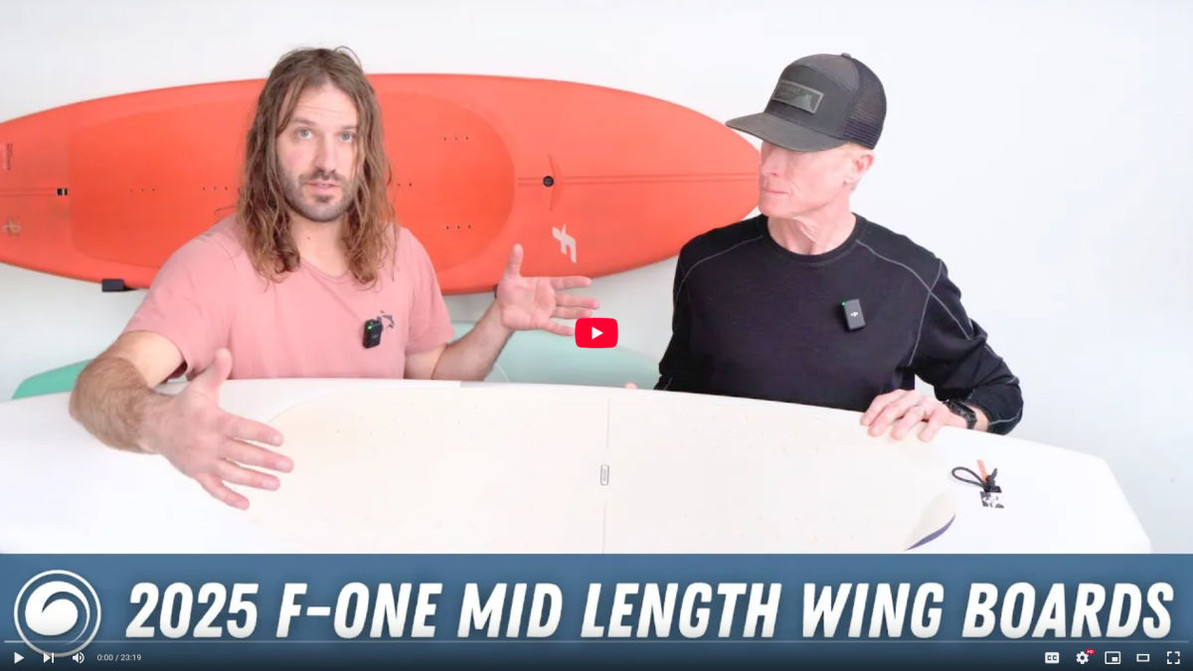2025 F-One Rocket Surf Prone, Rocket Wing Crossover, and Rocket Midlength Boards
Mid-length foilboards are rapidly growing in popularity and could soon dominate the market, especially as a second board for your quiver. F-One has responded with three offerings in the category, each with a distinct appeal. Jeff and Tucker were able to get their hands on the pre-production models and take them for a spin, and now they're ready to share some early insights on what each one does and who it's for.

What Is Mid-Length?
Mid-length is a rather broad term that can apply to a variety of boards, but generally they're boards that are longer and narrower than a typical foilboard of similar volume. They're often very efficient at planing and building speed to get up on foil. They offer a lot of performance and even some crossover potential, making some of them candidates for a one-board quiver.
Rocket Surf Prone
The Rocket Surf Prone is a little narrower, thinner, and has a lower volume than the others. It's the high-performance ripper of the bunch and, not surprisingly, requires a higher level of expertise for winging or parawinging. However, for prone surfing or Foil Driving, it's actually the easier option, short of getting into a more wing-specific board.
It's essentially a surf shape, but is elongated for more efficiency, easier paddling, and better front-to-back stability. Because of its length, you can ride a smaller foil when proning. Depending on your skillset, you could cross over to winging with this board. It's a little narrow at 18", but its 5'8" length has some performance benefits to get you up to speed, even at only 57L. It feels more like a 65-70L board for getting on foil. In fact, you don't want to pay too much attention to the volume on mid-length boards, as a rule of thumb. The length and planing ability, or bottom shape, are far more important qualities since the amount of flotation doesn't matter once you begin to move. A low entry rocker is super efficient and will get you up on a smaller foil than less efficient boards need.

With this being such a narrow board, Tucker felt the pad could have gone a little closer to the edges. While he had no trouble winging it and found it to be a great ripper in good conditions, if he planned to ride it with a wing regularly, he'd either bump up a size or wax around the edge of the pad so he could use its full width. Of course, it wasn't designed for winging, so that's not really a critique, but more of an observation for those looking to cross over with this board.
The Surf Prone has a somewhat sunken deck but is flat throughout the standing area. The nose has a bit of a bulb to help shed water, and there's a little kick in the tail. The pad, as mentioned, is pretty narrow, and you can wax around it or add a strip of pad if you like a wider stance than the stock pad gives you. For most surf foils, you probably won't need to go that wide, though.

The track box is pretty short, but it should be fine even for Foil Drive unless you're riding a foil that likes to be mounted far forward like the old Armstrong foils, or way back like early release Axis foils used to. Most foils today are designed to be ridden under your back foot, and for those this box is in a nice, neutral position. So don't worry about that and focus on getting the board length that's appropriate for your conditions and the size foil you're on.

A neat touch that comes with F-One boards is a mini-pad to protect the top of the board when you have it face-down for mounting your foil. Just stick it to the highest point forward of the main traction pad, which could be anywhere between the vent plug and the tip of the nose, and no longer will you scuff your board when you're putting it together in the parking lot.

Rocket Wing Crossover
The Rocket Wing Crossover is a crossover board between prone surfing and winging/parafoiling, and you can even SUP on the larger sizes. It's more stable than the Surf Prone and is essentially a Rocket Wing S elongated and is offered in a lot more sizes, especially at the larger end. If you've ridden the Wing S and loved it but wished for a longer version, the Crossover is a no-brainer. If you want a board that can get up in lighter wind but still charge in higher wind and ride waves, you won't find a lot of drawbacks here.

The Wing Crossover could be a one-board quiver for most riders. It's also a good choice for sizing down your current board to gain a lot of performance without sacrificing stability, ease-of-use, and light wind ability. Go ahead and size down 20 or 30 liters on this compared to a normal wing board and you won't give up any low-end performance.
The length is the spec you want to pay the most attention to. It's easy for us to adjust our balance side-to-side, but front-to-back is much harder. If you get the appropriate length for your skills and conditions, the board's length will give you the stability you need. The narrower width will give you efficiency while planing and get your rails out of the way when making a hard turn on foil. The specs on the board the guys have been testing is 5'6" long, 22" wide, and a volume of 80 liters. It's not quite so narrow compared to its length as the other boards, which is what makes it ideal as a crossover board.

The tradeoff for the extra width and stability is that the Wing Crossover won't get up to speed quite as quickly, but if you're coming from a larger board, you're going to feel more at home on a board like this and progress naturally into it. It's a board an intermediate or advanced rider will enjoy with a 1000 to 1400 cm2 foil in knee to head-high waves and 10 - 25 mph wind.
To attest to its crossover abilities, Tucker can take this one board out to wing in light wind or high wind, to do jumps, to ride waves, to parawing, to prone foil, to Foil Drive, and even to kite foil. It is that versatile and, if you choose your size wisely, really can be your one-board quiver.

Rocket Midlength
The Rocket Midlength is the largest in F-One's mid-length range. The one the guys checked out is 6'2" x 20" x 5.75" and has a volume of 95 liters. It's ideal for intermediate+ wing foilers who want to get out in light winds or ride small foils. A couple years ago downwind boards filled that niche, and they do still have their place in winging, but if you want to add some performance to your light wind riding, this shape is ideal. It's been a popular choice for the locals that are ready for their next board and need something to get them through the summer doldrums but still be manageable when the wind picks back up in the fall where a downwind board would be a lot to handle in higher winds and waves.
The Rocket Midlength is at the upper end of what we'd consider a mid-length board; it's almost a small downwind board. But that length gives you the speed and efficiency that you need to ride the smallest wing and foil possible, especially in lighter winds. If this is your goal, choose at least your usual volume since you will be using it to stay afloat until you can build enough power to get on a plane.

Now, if you're not planning to use this board in under 10 knots, then you can size down quite a bit. The only problem is that the boards do get narrower as you lose length, and with the pad not coming out to the edge you may wish to use some wax or extend the pad so you can get more purchase out toward the rails when you're on a wider foil, which is what you'll be on a lot of the time in lighter winds.
If you find yourself sizing down, you might want to take a look at the Rocket Wing Crossover instead. The Rocket Midlength is a super light wind machine and makes a better complement to a main board to get the very most out of those light days, rather than standing alone as a one-board quiver.
One exception would be if you only ride inland lakes and efficiency is your primary need. If you're not ripping turns or jumping and just need something that'll get you moving, then this would be your main board.
Another exception would be for new riders. If you're not going into big waves and charging in wind over 25 knots, this is a great board. It can still handle winds around 18 or 19 knots, and that's going to be the upper limit where a rider that's still learning is going to feel comfortable.
While it can be used as a downwind SUP by those very skilled in that area, this is really a board for winging, and it works well with a parafoil too. Tucker's been out with the Midlength on a parafoil, cruising around and riding waves, and he had fun.

Summary
It's exciting to see what different brands are coming out with in the mid-length range. It's always nice to have more options to find that board that's a great match for your goals out on the water and will maximize your fun. Of course, with more options comes a more difficult decision, so don't hesitate to give us a call to talk through what you want to do and hear what we'd choose in your place.

MACkite Subscription Links:
YouTube | Instagram | Spotify Oddcasts
Contact MACkite Below:
800.622.4655 | Kiteboarder@MACkite.com | LIVE Chat Messenger


Recent Posts
-
2025 KT Ginxu Super K Review | Why This Isn't Last Year's Board
Mid-length, or "midi" boards, have gained a lot of traction in the past couple years. They're ve …1st May 2025 -
Light Wind Kiteboarding Magic? The Reedin WhisperModel Might Be the Answer
Jeff from MACkite had a chance to meet up with Kevin Langeree of Reedin in Cape Town, South Afri …22nd Apr 2025 -
Hot New Releases: MACkite Brand Parawing & Mystic Majestic Ex Custom Harness
MACwing v.5 Beta Single Skin Single Use Jake and Ryan from MACkiteboarding unveiled an excit …1st Apr 2025




